Is the New Drobo 8D Thunderbolt 3 RAID Enclosure Too Little, Too Late?
Of all the brands that we talk about here on NASCompares, one that has always been popular with content creators over the last decade is Drobo. They are a brand that has been involved in numerous data storage devices, ranging from direct attached storage (DAS) and network attached storage (NAS), all the way back since 2007! Today I want to review and discuss their latest hardware release, the Drobo 8D, a Thunderbolt 3 enabled RAID DAS 8-Bay storage drive with enhanced SSD caching and internal battery for protection from critical data loss in the event of a power failure. These are some cool features and the Drobo 8D is still one of the most competitively priced Thunderbolt 3 RAID Solutions in the market right now, but since the last 8-Bay DAS from Drobo was back in 2009, with the USB 2.0 and FW800 DRPR1A21, have Drobo left it a little too late for Photo and Video Editors who have since moved over to other brands? The Drobo 5D3, released almost 2 years ago, features almost all of the hardware available in this new 8D, and at half the price, so what makes the new RAID enabled Thunderbolt3 8-Bay worth your time and your data? Let’s find out.
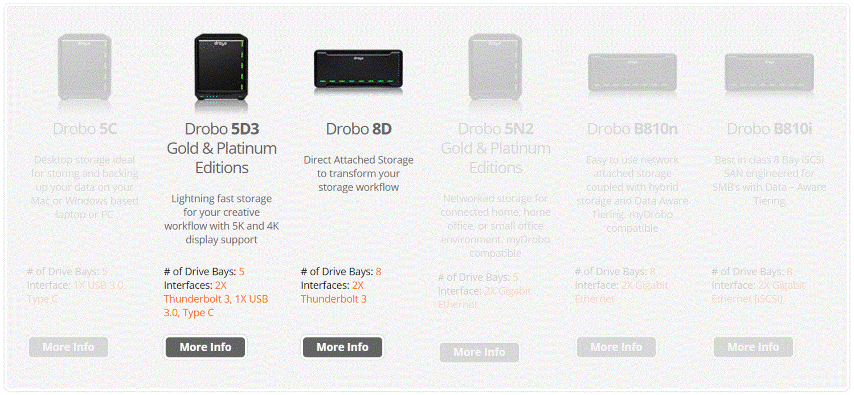
The first important thing you have to keep in mind throughout this review is that if you are looking for a fluid RAID enabled Thunderbolt 3 Storage device that can be easily set up and forgotten, populated by drives that you choose, at the best price available for a RAID TB3 DAS – You found it! I cannot fault the Drobo 8D in its construction, value and desirability for those that want easy, fast, Thunderbolt 3, RAID storage. Right now, you can get ALMOST all of these features from other brands, but not ALL of them, in anything else but the Drobo 8D. For example, below are the top 5 Thunderbolt 3 DAS storage options and how they compare with the Drobo 8D TB3 DAS:
Fast Review:
![]()
The Akitio Thunderbolt 3 Range – The Akitio range of TB3 DAS solutions is good, arrive unpopulated and are competitively priced. However, the majority of their range does not include RAID protection above 2 Bays of storage, only available in up 4 HDD slots max and many are only Windows compatible
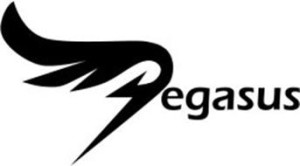
The Pegasus Thunderbolt 3 Range – A well known and enterprise brand, they are of excellent product quality, but arrive pre-populated with hard drives (so the price is higher to accommodate this), feature weaker internal RAID handling processors and are generally one of the most expensive brands for hardware you can buy.

The LaCie Thunderbolt 3 Range – A very, VERY well known brand for content creators of photos and video in post-production. However, like Pegasus, arrive pre-populated as standard and has less of an established history in larger scale DAS than Drobo

The Areca Thunderbolt 3 Range – Probably the closest brand to Drobo right now for what you get for your money, they have a TB3 RAID 4,6,8 and 12 Bay – all competitively priced, all arriving without hard drives and good internal hardware. The only issue? Noisier than Drobo and a much more dated design (if this matters to you)

The G-Tech Thunderbolt 3 Range – Another well-known brand, Gtech has some great TB3 solutions but…. pre-populated, expensive, etc, etc. You may see a pattern by now!
So, if you are reading this because you want a direct attached storage device that IS:
- 8-Bays
- Thunderbolt 3
- Handles its own RAID with 1 or 2 HDD redundancy
- Competitively Priced
- Arrives Unpopulated, so you can use whichever type/quantity/capacity of drives you want
- Modern Design
- Quiet
If these factors are ALL dealbreakers for you, then the Drobo 8D is what you need and you can stop reading. For the rest of you that only need some of these features, or are still unconvinced, let us take a closer look at the hardware and software of the Drobo 8D Thunderbolt3 8-Bay RAID enclosure.
The Drobo Thunderbolt 3 8D DAS – Design
The retail packaging for Drobo devices has always been something I have liked. It borrows heavily from the Apple design style when it comes to retail packaging and alongside 1:1 image of the product, you are given a very clean and clear message about what this device can do and what it arrives with
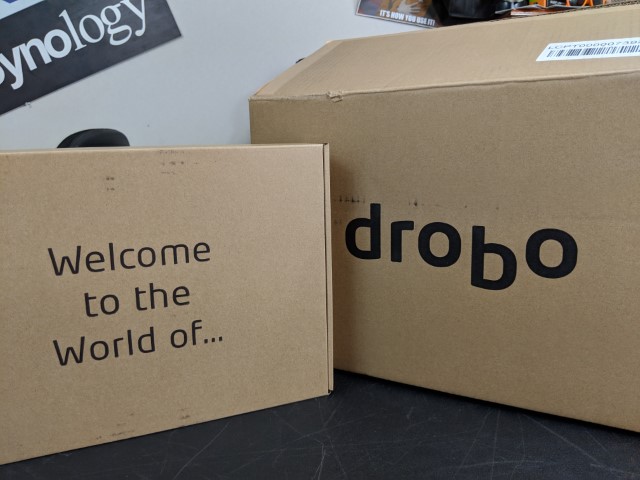
The box is certainly heavy, but that shouldn’t be a huge surprise for an 8 bay Thunderbolt DAS device. The internal packaging is also very well presented and there are lots of branded touches that are a staple of the retail design of Drobo
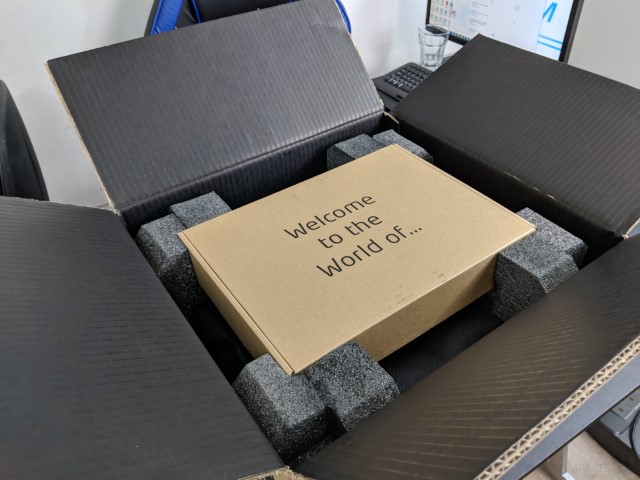
If we remove the accessories box, we find that there isn’t a huge number of extra bits included with your Drobo 8D purchase. Inside we find the Drobo Thunderbolt 3 DAS itself, along with a 1metre Thunderbolt 3 USB-C cable and a mains power cable – the Drobo 8D features an internal PSU, so no massive external power brick to deal with.
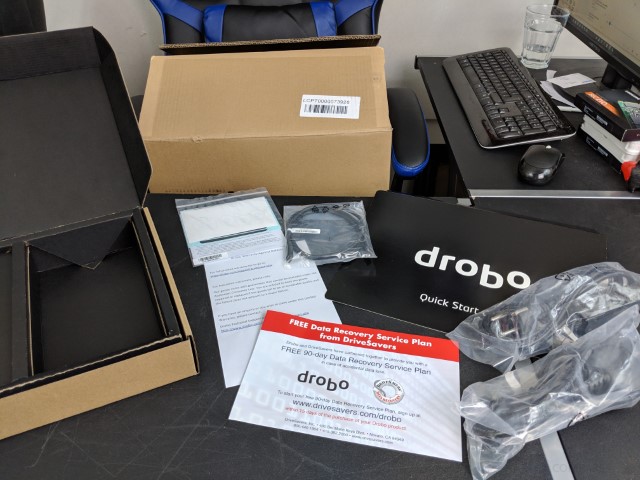
Another qwerky presentation feature that this unit arrives with, like other Drobo hardware, is that the unit arrives in a branded black tote bag. I cannot recommend enough that you DO NOT carry a large scale RAID enabled 8 Bay DAS solution that, when populated, can weigh over 10KG, in a canvas bag! But I do like the bag and I have seen several post-production editors in Soho and Poland street wrap their Drobo 5N2 or 5D3 in the provided tote bag for protection from dust etc – so maybe there is an audience for this!
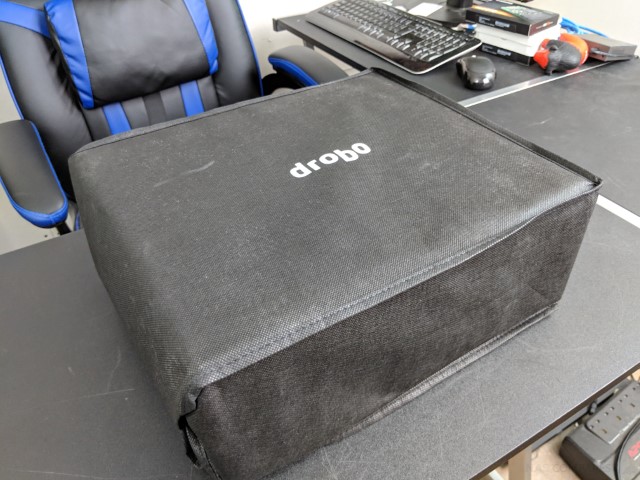
Once we remove the Drobo 8D from the canvas bag, we can take a good look at this rather imposing looking RAID enclosure. Measuring in at 31 x 14 x 36 cm, this is surprisingly compact for an 8-Bay device. There are lots of reasons for this, such as the way media is installed and the front panel. But for now, let’s focus on that front panel.
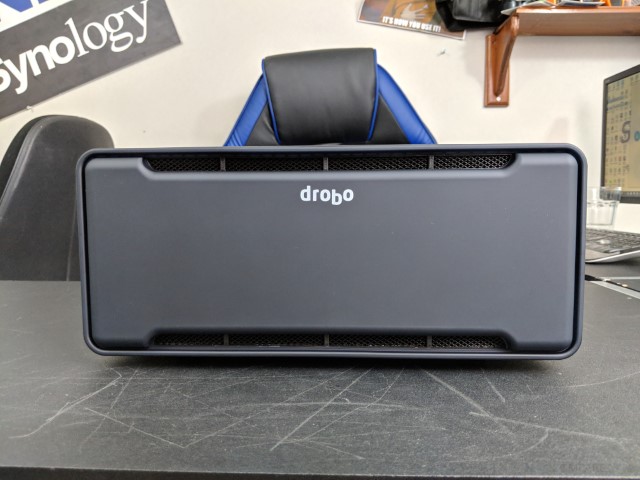
The Drobo Thunderbolt 3 8D DAS – External Hardware
The front panel of the Drobo 8D is very well designed and all too often gets overlooked. It is a magnetized rectangular panel that is ventilated along all edges and features slots for LED lights located inside. The design is incredibly sleek and Drobo have really been a company that has stuck with this design for the over a decade. They are well aware that they have a very distinctive look and have doubled down on this with the Drobo 8D.
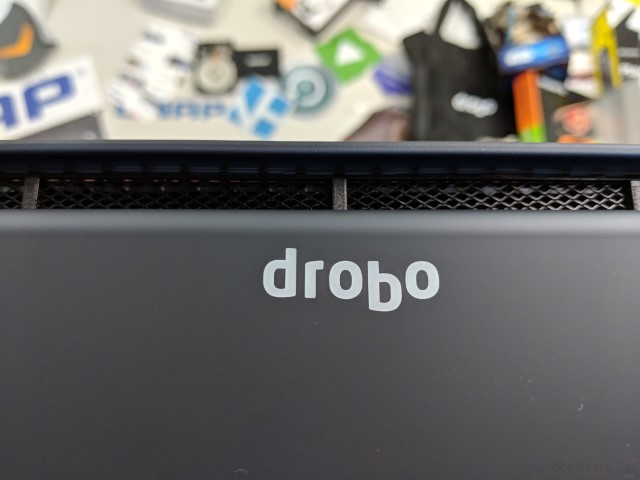
Removing this panel (again, magnetized, not on a hinge or clip) you find two interesting things. The first is a rather interesting LED guide. As mentioned in previous reviews of both the Drobo5D3 and the Drobo 5N2, their storage range contains a nifty smart LED light indication system. LEDs on drives are not new, but no one (and I really am surprised to say, NO-ONE) has used them like this.
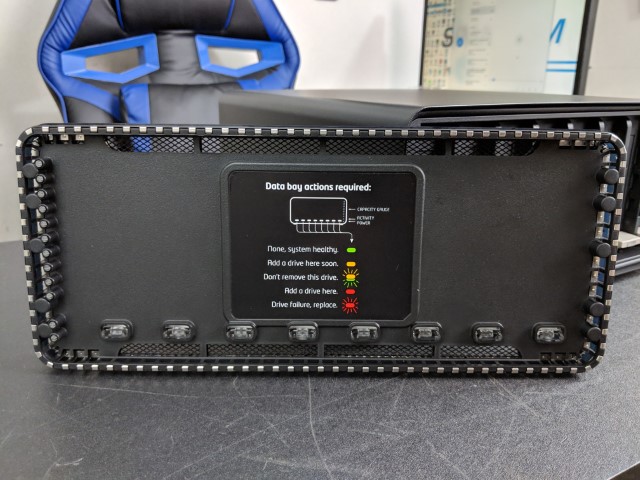
Each bay has an LED and so does access etc, but there are combinations of LEDs that tell you as much information as an LCD panel, without being complex. Additionally, these lights can be dimmed to nothing if you wish from the user-interface on your connected host system.
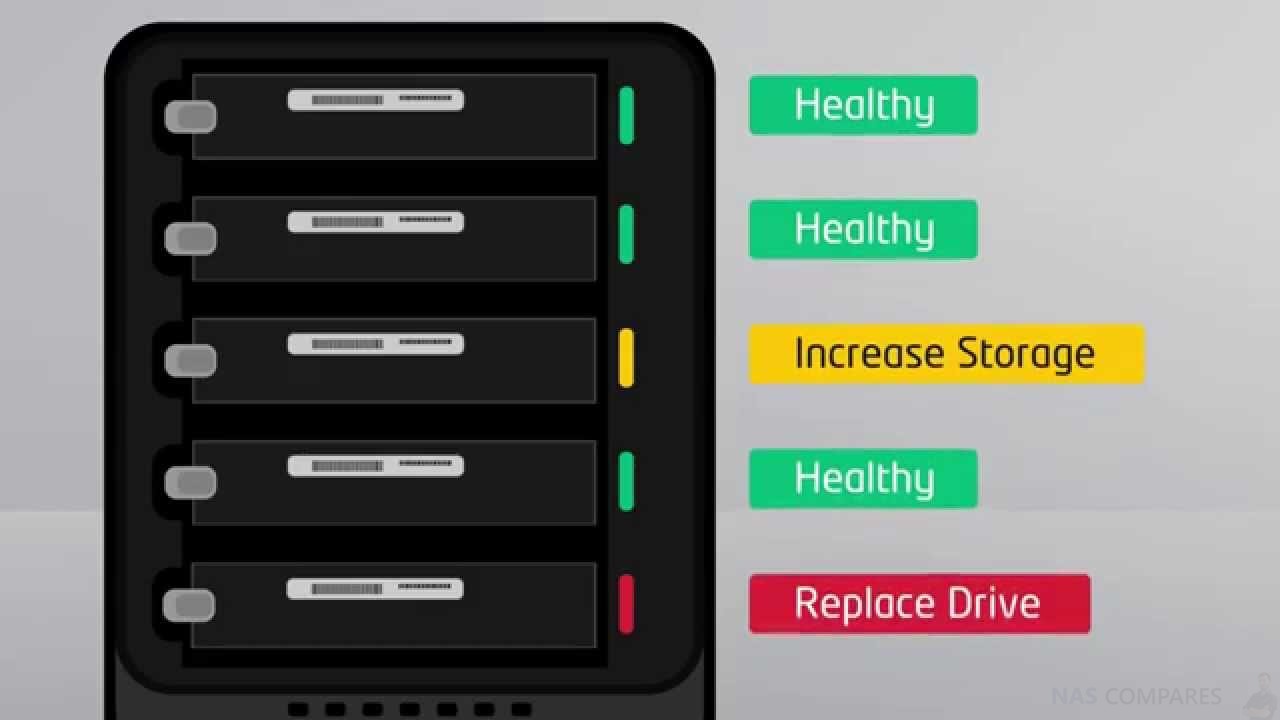
One of the reasons that the Drobo 8D RAID Box manages to be surprising compact, is the fact that it features a slot loaded bay system – no trays. This means that the bays are closer together, but still individually held in the system. This will also reduce vibration in a number of ways, which also helps decrease noise.
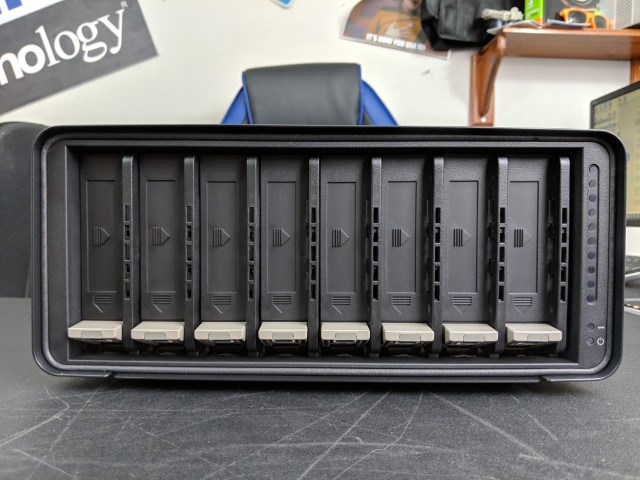
This does make things a little difficult for those that want to use SSD drives in this device for their primary storage, or as an extra layer in the tiered storage system (I will get on to that later) and you will need 2.5″-to-3.5″ adapters to install this media. Otherwise, the Drobo 8D supports the very latest 14TB and 16TB hard drives (coming soon) from Seagate, WD and Toshiba.
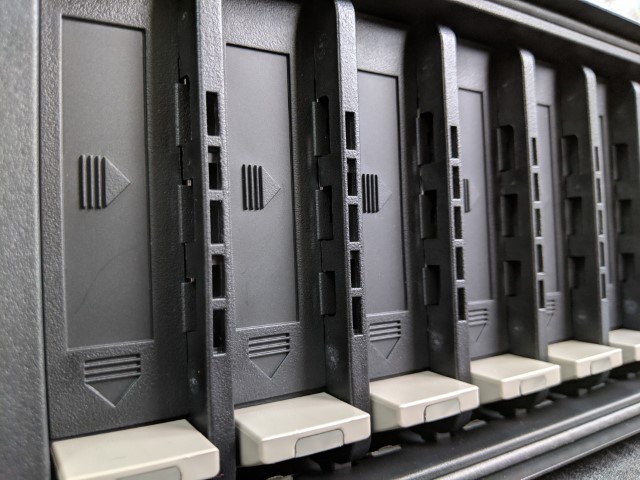
Coming back to those LED, there is another unique area where Drobo have used them and that is in the innocuous blue LED lights across the right side. These lights are used to indicate the internal storage. This means, in real terms, that just glancing at the device will give you an indication of how much space you have used and how much remains, without having to access the device via Thunderbolt 3. I am still staggered that other DAS brands have not stolen this idea and can only assume that it is protected by Drobo, as it is a great feature that is massively overlooked.
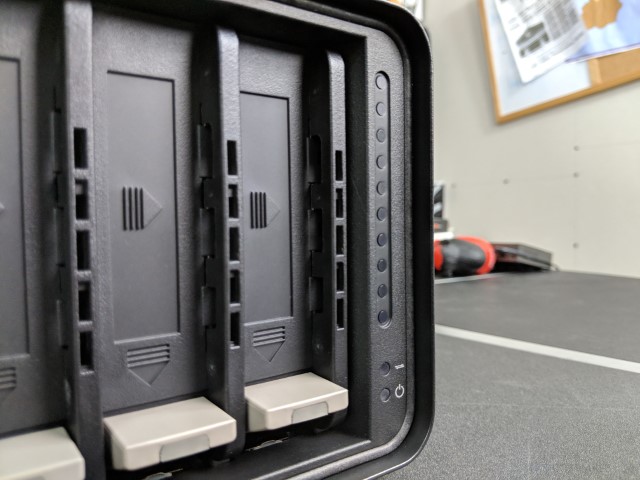
The sides of the Drobo 8D chassis are formed of a complete, metal surrounding panel taht circles the device. This means that it is incredibly sleek and seamless. I don’t think it is an overstatement to say that a number of Drobo buyers have previously bought the device because of this design and it is something that Drobo is keen not to change.
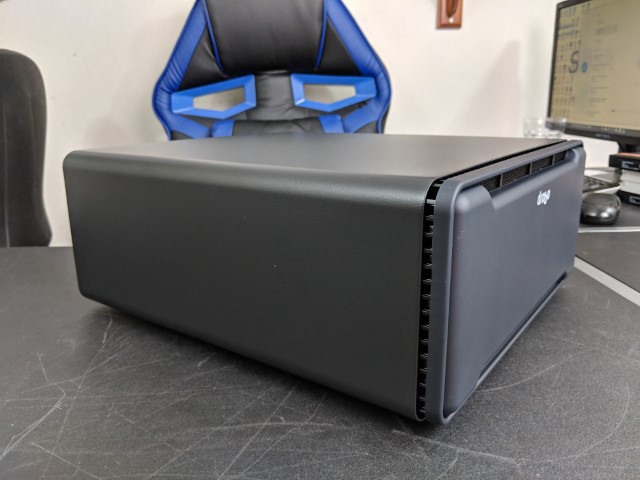
Once we turn the Drobo 8D around, we can see alot more detail. They have still maintained a remarkably minimalist design, but still somehow managed to keep it looking rather cool. I will highlight my disappointment at the lack of a USB port (as seen on the Drobo 5D3) as this is a function that I know from users is a good way for the storage to be usable with newer and older devices alike in a business environment, but aside from that, it provides everything that we would expect, plus a little something extra.
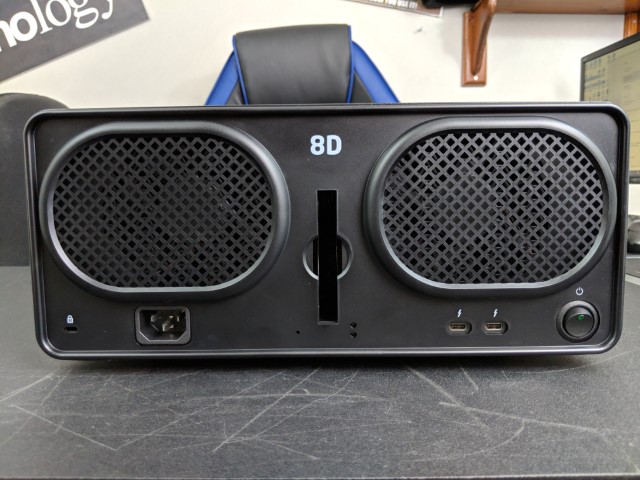
The rear cooling fans are rather impressive. These two fans, that do spin up a little high at initial boot, soon calm down and can be adjusted in rotations per minute (RPM) in the version of the Drobo Dashboard I used. This amount of active cooling is to be expected in an 8-Bay device and given the compact nature of the Drobo 8D, will be needed when more enterprise mechanical drives are installed. Though they do seem quieter than those found on the Areca ARC-8050T3-8, overall operational noise will always depend heavily on the type of storage media you use.
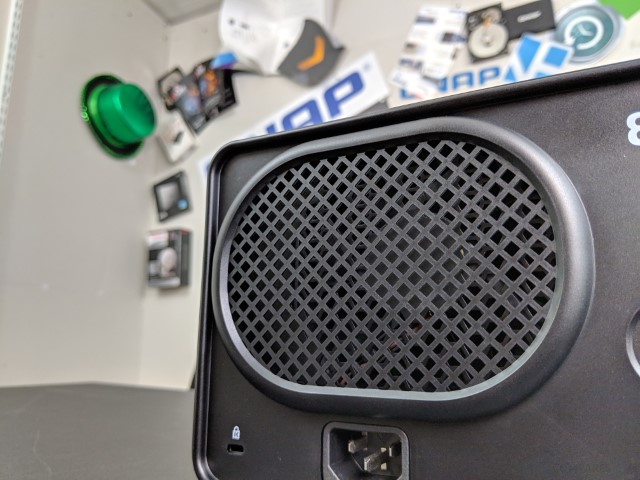
The device also, of course, features two Thunderbolt3 USB-C ports that allow for a theoretical 40Gb/s data access speed, as well as support for daisy chaining. For those that are not aware, daisy chaining is the ability to connect multiple TB3 devices together and then one end of the chain being connected to a Mac system, letting it access all the devices in the line. The Drobo 8D connects up to six Thunderbolt devices or five devices and a monitor at the end of the chain. Supports one 5K or two 4K displays (with a Thunderbolt dock) to spilt it effectively. One fact that, though obvious to many of us, is often skipped over by ALL Thunderbolt 3 DAS/NAS providers is that although you have a max speed of 40Gb/s via thunderbolt3, you are still going to have the maximum speed of the storage media and the RAID to factor in.
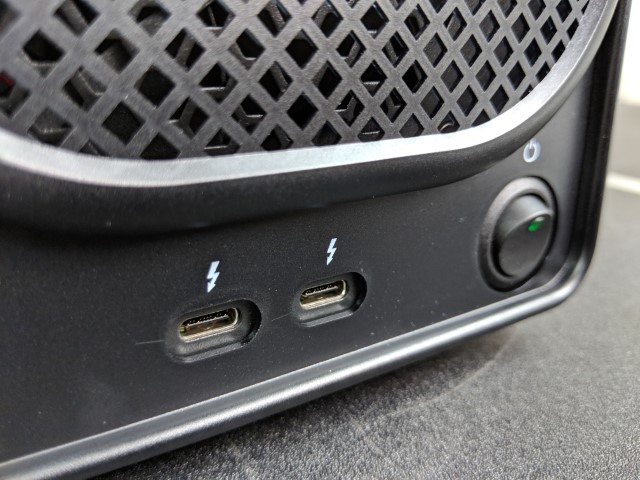
It is important to remember that although Thunderbolt 3 can give you up to 4,000MB/s speeds, a single Hard drive will give you around 100-200MB/s Read/Write (standard HDD or Enterprise HDD) and in a RAID configuration, will boost this by around 50-80MB/s with each added drive. SSD, though faster at around 400-500MB/s, will add around 100-150MB/s per drive in the right RAID. So, do not think that jsut buying the Drobo 8D (or anything Thunderbolt 3 DAS) will just mean you get 40Gb/s speeds – it is VERY dependant on the type of media, number of media drives and RAID type.
Another feature that has been carried over from more recent Drobo DAS/NAS devices that have been added in the Drobo 8D (in an improved form) is the SSD Caching bay (or Accelerator Bay, as they call it). This provides you with the option to boost internal Read and Write speeds on your ALL Hard Drive RAID array, buy using a portion of fast access SSD storage. Data is then moved over to this area when frequently accessed, or to aid caching during intense read/write actions. Most storage arrays use either all hard drives or all SSDs. The Drobo 8D delivers the best of both worlds by intelligently combining hard drives and SSDs to deliver both capacity and performance. The Drobo 8D gives you the option to enable Hot Data Caching through the Drobo Accelerator Bay on the rear slot. Using an SSD allows access to most frequently read data to deliver blazing fast speeds. This boosts the performance of popular applications such as Apple’s Final Cut and Adobe Lightroom. Think of it as the middle ground between the good price vs capacity offered by hard drives, but with a single SSD Speed advantage, spread across those hard drives. This is a poor way to describe SSD caching, but it does the job! SSDs can also be utilized in the front bays of the Drobo 8D for Data-Aware Tiering, allowing for transactional data to migrate to the SSDs. This ensures that both writes and reads are accelerated and is a similar system to that of the QTier system from QNAP NAS – but much faster in this DAS environment.
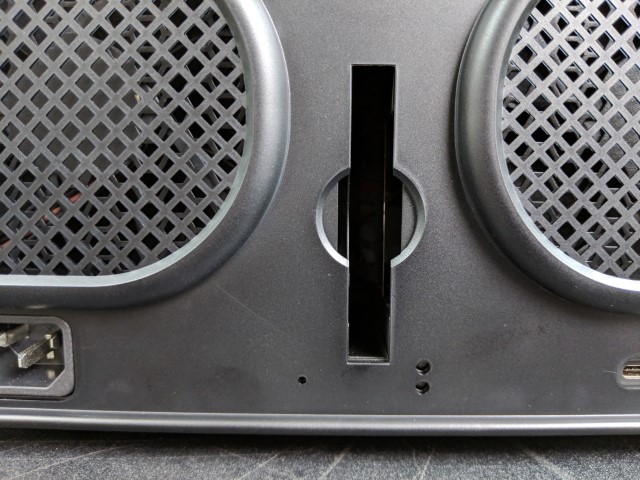
I still maintain that, especially in terms of hardware, that the Drobo 8D is a solid device, that seems to trade on it’s looks alot more than most. The external hardware is fairly standard, but what about the internal hardware? The software platform and support? Let’s dig a little deeper.
The Drobo Thunderbolt 3 8D DAS – Internal Hardware
The internal hardware of the Drobo 8D Thunderbolt 3 DAS is noticeably higher than most DAS devices – which in itself is pretty impressive. Direct Attached Storage devices require much, much lower hardware spec internally and most brands will make do with a very basic RAID-on-Chip (RoC) to handle a software handled RAID 5 or 5AID 6. The 8D DAS features an impressive 1.6GHz quad-core Marvell ARM-based CPU (this rivals a number of NAS devices, as well as largely out powers most DAS devices) and is used to operate a number of unique Drobo features (not just those fancy LEDs). For a start, when using your Mac to access this device, you can use the Drobo Dashboard software to do more than just access files and folders. You can use it to monitor overall storage, system values, power use, control hardware operations and set up bespoke notifications and properties. You can, of course, just set it up in your Mac Disk Utility app to be a brainless storage drive that handles it’s own RAID, but you get lot more out of the Drobo 8D with it’s intuative and helpful dashboard interface that is comparable to that found from WD and Netgear NAS software. New to the Drobo product line is the Intelligent Volume Management technology available on the 8D. This technology combines the flexibility of manual volume configuration with the convenience of Drobo’s legendary automation, allowing for separation of file systems as customer needs dictate. The 8D allows the creation of up to 16 volumes with a maximum 128TB volume size, and a 256TB storage pool. However, these volumes have to live on a dependable RAID protected storage pool and this is where BeyondRAID from Drobo steps in.
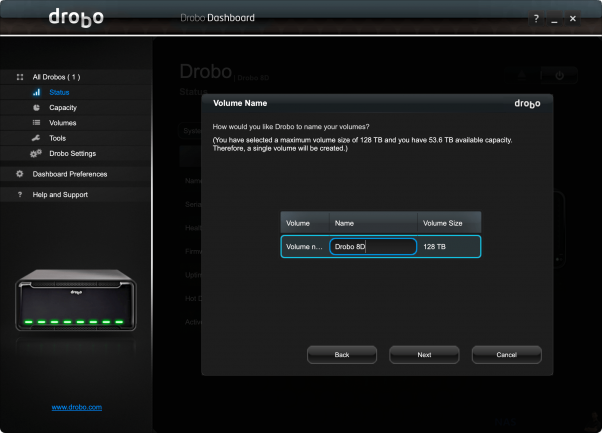
If you have been looking at Thunderbolt3 RAID-enabled storage, then chances are that you are aware of RAID. Just in case though, RAID (Redundant Array of Independent Disks) is a system of combining multiple Hard Drives or SSDs into a single visible storage space (a storage pool) and can create better speeds, or a safety net of storage in case of a drive failure that is known as redundancy. Though most devices support RAID in one form or another, it can be very restricting in the long run, with the requirement that you need all drives to match (which can be a pain when upgrading drive later). The Drobo 8D implements a storage technology that they call BeyondRAID in their Drobo storage devices.
While not a true RAID ISO spec extension, it does provide for using up to 12 SATA hard drives in the devices and consolidating them into one big pool of storage. It has the advantage of being able to use multiple disk sizes at once, much like a spanned volume/volume set or the Synology Hybrid RAID, while providing redundancy for all disks and allowing a hot-swap upgrade at any time. Internally it uses a mix of techniques similar to RAID 1 and RAID 5. Depending on the amount of data stored on the unit in relation to the installed capacity, it may be able to survive up to 3 drive failures, if the “array” can be restored onto the remaining good disks before another drive fails. The amount of usable storage in a Drobo unit can be approximated by adding up the capacities of all the disks and subtracting the capacity of the largest disk. Only Drobo and Synology provide this kind of RAID in their respective forms and it is one of key reasons a number of content creators use a Drobo DAS and a Synology NAS in their workflow as a local and network data storage solution.
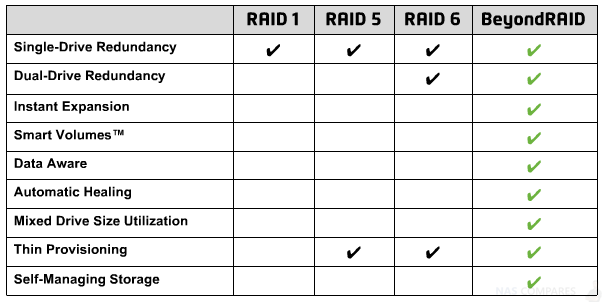
Finally, a very, VERY unique feature of the Drobo DAS series and something that has continued into the 8D, is the inclusion of an internal battery to provide protection from damage to your data/drive in the event of a critical power failure (power cut, accidental power loss, PSU dying, etc). This is something that almost no other RAID storage provider has offered and definitely not in a Thunderbolt 3 storage array. Similar battery options are available in optional extras in bigger server arrays from companies like LSI and Adaptec (in the form of a BBU add-on), but it is awesome to see it in the Drobo 8D. Here is how it works, demonstrated in the Drobo 5N2 in a previous video)
In every modern Drobo, they include this battery backup technology to protect data in memory or cache. When power spontaneously goes away, Drobo moves any in-flight data to onboard flash in your Drobo, so it will be protected and moved to your disk drives once power is restored. This ensures your important information is safe and sound. Even better, your battery recharges itself and is designed to last for the life of your Drobo. I still don’t see how other brands haven’t tried to steal this idea and am very impressed with Drobo, that they have managed to keep this feature in-house in a closed DAS system as the 8D.
The Drobo Thunderbolt 3 8D DAS – Verdict
At the start of this interview, I made it abundantly clear that, although Drobo is a brand that seldom releases units (5-10 years apart in some cases) when it does, it is a solid and reliable product on the whole. They have a business model that is fantastically rigid and for better or worse, the Drobo 8D is a product of that release model. There are certainly areas of improvement for the Drobo 8D, the SSD Caching bay is a single slot (so Read and Write caching across two drives is not an option without losing one of the 8 storage bays). Additionally, the lack of the USB bay found in the previously released Drobo 5D3 5-Bay at half the price of the 8D3 is disappointing. But these details aside, it is hard to fault the Drobo 8D Thunderbolt 3 DAS device that stands out remarkably well from its competition. A number fo the newly advertised features are things that other NAS brands have advertised, but almost none of them are available in this DAS platform – which makes the Drobo 8D unique in a number of ways. If you are looking for a robust, easy, fast, affordable and customizable Thunderbolt 3 storage device with RAID inside, you are going to struggle to do better than the Drobo 8D. I recommend it.
Fast Review:
| Pros of the Drobo 8D Thunderbolt3 DAS | Cons of the Drobo 8D Thunderbolt3 DAS |
|
|
You can buy your Drobo 8D using the links below:
Best Prices Available for the Drobo 8D
I hope the Drobo 8D DAS Review helped you. Now I need to ask you for a little help, This site needs your help to keep people informed for free. If you found this advice helpful, why not help keep it alive by clicking one of the links in the pages (just a click is all it takes) and a % of whatever you buy there goes towards to the running of this site. This will help me help as many users as possible and keep people informed on how storage can be used in every area of their lives.
📧 SUBSCRIBE TO OUR NEWSLETTER 🔔🔒 Join Inner Circle
Get an alert every time something gets added to this specific article!
This description contains links to Amazon. These links will take you to some of the products mentioned in today's content. As an Amazon Associate, I earn from qualifying purchases. Visit the NASCompares Deal Finder to find the best place to buy this device in your region, based on Service, Support and Reputation - Just Search for your NAS Drive in the Box Below
Need Advice on Data Storage from an Expert?
Finally, for free advice about your setup, just leave a message in the comments below here at NASCompares.com and we will get back to you. Need Help?
Where possible (and where appropriate) please provide as much information about your requirements, as then I can arrange the best answer and solution to your needs. Do not worry about your e-mail address being required, it will NOT be used in a mailing list and will NOT be used in any way other than to respond to your enquiry.
Need Help?
Where possible (and where appropriate) please provide as much information about your requirements, as then I can arrange the best answer and solution to your needs. Do not worry about your e-mail address being required, it will NOT be used in a mailing list and will NOT be used in any way other than to respond to your enquiry.

|
 |
Minisforum N5 NAS, 6 Months Later - Better, Worse, the Same?
Beelink ME Pro NAS Revealed
Best SOLID STORAGE NAS of 2025
Should You Worry About the NanoKVM Hidden Microphone?
Best Cheap NAS of 2025
Minisforum MS-02 Ultra - WHO IS THIS FOR??? (The First 48HRs)
Access content via Patreon or KO-FI





Discover more from NAS Compares
Subscribe to get the latest posts sent to your email.


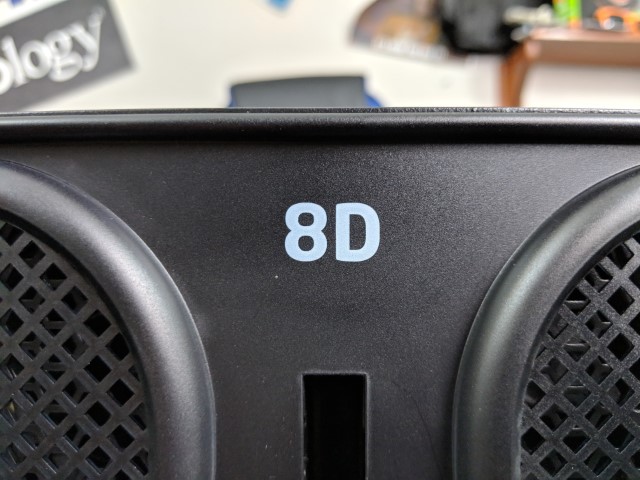



I have a Drobo 8D now to hold my Plex library and love it, but eventually I will need to upgrade it. Any suggestions for a rack mountable Synology/Drobo DAS???… I NEED direct attached so my whole library can stay cloud backed up to Backblaze, their NAS plans are hundreds $$$ per month vs. the $10 it cost for DAS.
REPLY ON YOUTUBE
Ive got this and its the best and I really hope Drobo are still alive as they are so quiet!!
REPLY ON YOUTUBE